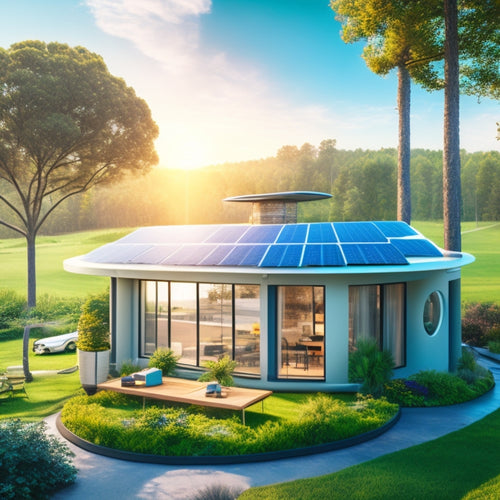
Maximize Energy Savings With Rainwater Harvesting Systems
Share
By integrating rainwater harvesting (RWH) systems into your home or building, you can greatly reduce your energy consumption and lower your carbon footprint. RWH systems collect rainwater for non-potable uses, decreasing the demand for treated water and the energy needed for treatment and distribution. Incorporating green roofs and solar panels can further minimize your carbon footprint. Energy-saving pumping solutions, like high-efficiency motors and solar integration, can sustainably power pumping systems. To maximize energy savings, it is crucial to design efficient water storage systems, implement proper filtration and treatment processes, and monitor your system's performance. Now, investigate the various components and strategies that can help you optimize your rainwater harvesting system.
Key Takeaways
- Reducing energy consumption by 40% is possible by using rainwater harvesting systems for non-potable water needs, decreasing the demand for treated water.
- High-efficiency motors and solar integration in pumping systems minimize energy losses and reduce carbon footprint.
- Efficient storage systems, such as modular tanks, maximize storage capacity in limited spaces and reduce operational costs.
- Implementing rainwater filtration and treatment processes ensures the safety of harvested water while reducing filtration energy consumption.
- Real-time monitoring systems optimize rainwater harvesting, reducing stormwater runoff and providing valuable insights for system improvement.
Reducing Energy Consumption Through RWH
Nearly 40% of a typical household's energy consumption is attributed to water treatment and distribution. By implementing a rainwater harvesting (RWH) system, you can greatly reduce this energy burden.
RWH systems collect and store rainwater for non-potable uses, such as flushing toilets and washing clothes, thereby reducing the amount of treated water needed. Additionally, incorporating sustainable practices like green roofs and solar panels into your RWH system can further minimize your carbon footprint.
This, in turn, decreases the energy required for water treatment and distribution. You can achieve rainwater efficiency by integrating RWH systems with your existing water infrastructure.
Efficient Water Storage Systems
You'll need to take into account two key factors when designing an efficient water storage system: the tank material and the design's spatial efficiency.
The tank material you choose will impact the water's quality and the system's overall durability, so it's crucial to select a material that won't contaminate the harvested water or corrode easily.
In addition, integrating energy-efficient systems, such as solar-powered charging solutions, can further reduce operational costs and promote eco-friendly practices.
Tank Materials Matter
Since efficient water storage is an essential aspect of rainwater harvesting systems, the material used for the tank plays an important role in guaranteeing the quality and safety of the collected water.
You'll want to choose a material that guarantees tank durability and can withstand outdoor conditions. Consider materials with good insulation properties to prevent water from freezing in cold climates or overheating in warm climates.
Additionally, just like high-efficiency solar panels maximize energy savings, a well-designed rainwater harvesting system can also lead to significant energy savings.
Polypropylene and polyethylene tanks are popular choices due to their resistance to corrosion, durability, and low maintenance requirements.
Stainless steel tanks offer excellent durability and resistance to corrosion, but may be more expensive.
Whichever material you choose, make sure it meets local health and safety standards to guarantee the quality of your harvested rainwater.
Space-Saving Design Options
In cramped urban spaces or areas with limited land availability, rainwater harvesting systems must be designed with efficiency in mind.
You'll want to reflect on space-saving design options that maximize storage capacity while minimizing footprint. For instance, when evaluating fleet energy needs and consumption, it's crucial to conduct an energy audit to gather data on vehicle energy usage.
One approach is to incorporate vertical gardens into your system, which can provide additional storage capacity while also creating a lush green space.
Modular systems are another option, allowing you to customize your system to fit your specific needs and available space. By stacking or arranging modules vertically, you can store more water in a smaller area.
These efficient water storage systems enable you to harvest rainwater even in areas with limited space, giving you the freedom to conserve this precious resource.
Rainwater Filtration and Treatment
Rainwater harvesting systems require a filtration and treatment process to guarantee the collected water is safe for use.
You'll need to select the right filtration technologies and treatment methods to remove contaminants, sediment, and bacteria from the harvested rainwater. This ascertains the water meets health and safety standards for irrigation, toilet flushing, and even drinking water.
Effective filtration technologies include screen filters, disc filters, and membrane filters, which can remove particles as small as 0.01 microns. Additionally, integrating renewable energy sources, such as solar power, can considerably reduce the energy consumption of the filtration and treatment process, promoting sustainability.
Moreover, utilizing energy storage systems can stabilize the grid and ascertain reliable operation of the rainwater harvesting system.
Treatment methods may include UV disinfection, chlorine injection, or ozone generation to eliminate bacteria and other microorganisms.
Energy-Saving Pumping Solutions
You've guaranteed the harvested rainwater is safe for use by implementing a reliable filtration and treatment system.
Now, it's time to optimize the pumping system to minimize energy consumption. You can achieve this by incorporating energy-saving pumping solutions.
Consider installing a pump with a high-efficiency motor that reduces energy losses. Additionally, examine solar integration options to power your pumping system, reducing your reliance on the grid and further minimizing your carbon footprint.
By doing so, you'll not only reduce your energy bills but also increase your system's overall energy efficiency.
This collaboration between rainwater harvesting and renewable energy sources will help you maximize your energy savings and achieve a more sustainable lifestyle.
Smart Rainwater Management Systems
You'll find that smart rainwater management systems are designed to optimize rainwater harvesting by reducing stormwater runoff, providing efficient water storage solutions, and utilizing real-time monitoring systems to guarantee maximum water conservation.
These advanced systems enable you to make data-driven decisions about your rainwater harvesting setup, leading to improved performance and reduced environmental impact.
Stormwater Runoff Reduction
Stormwater runoff poses a significant threat to urban and suburban ecosystems, as it carries pollutants, sediments, and excess nutrients into waterways, degrading water quality and habitats. By implementing rainwater harvesting systems, you can reduce stormwater runoff and alleviate the environmental impact. This, in turn, helps you comply with regulatory requirements and promotes community awareness about the importance of stormwater quality.
| Benefits | Description |
|---|---|
| Urban Planning | Reduces burden on drainage infrastructure, allowing for more efficient urban planning |
| Flood Mitigation | Decreases flood risk by reducing peak stormwater flows |
| Ecosystem Benefits | Preserves natural habitats and improves water quality, enhancing ecosystem health |
| Green Infrastructure | Encourages the use of green spaces, reducing urban heat island effect and improving air quality |
Efficient Water Storage Solutions
Through the strategic integration of rainwater harvesting systems, building owners and managers can optimize water storage capacity, reducing the pressure on municipal drainage networks and mitigating the environmental impacts associated with stormwater runoff.
By implementing efficient water storage solutions, you can maximize your energy savings and take a significant step towards water independence.
To achieve this, consider the following smart rainwater management systems:
-
Gravity fed systems: These systems use gravity to feed water into storage tanks, reducing energy consumption and increasing system reliability.
-
Modular tanks: Modular tanks offer flexibility in design and can be easily expanded or reconfigured as storage needs change.
-
Customized storage solutions: Tailor-made storage solutions can be designed to meet specific building requirements, ensuring maximum efficiency and water savings.
Real-Time Monitoring Systems
As you optimize your rainwater harvesting system with efficient storage solutions, it's equally important to guarantee that you have real-time visibility into your water management operations. This is where real-time monitoring systems come in, providing you with the information you need to maximize energy savings. With smart rainwater management systems, you can access real-time data on your water usage, storage levels, and system performance.
| Feature | Benefits | Description |
|---|---|---|
| Real-time Data | Optimize water usage, detect leaks | Access current system data, including water levels and flow rates |
| Usage Analytics | Identify areas for improvement | Analyze historical data to identify trends and opportunities for optimization |
| Automated Alerts | Reduce downtime, prevent overflow | Receive notifications when system thresholds are exceeded or maintenance is required |
| Remote Access | Monitor and control from anywhere | View system data and make adjustments remotely, ensuring maximum efficiency |
Water Conservation Benefits
You can greatly reduce your water bill by utilizing rainwater, which is fundamentally free.
This approach not only saves you money but also contributes to a more sustainable future. By capturing rainwater benefits, you'll be implementing effective conservation strategies that minimize your reliance on municipal water supplies.
Here are three key advantages of rainwater collection:
-
Reduced potable water demand: Collecting rainwater for non-potable uses, such as flushing toilets and washing clothes, decreases the amount of treated water needed.
-
Lower water bills: By using rainwater for irrigation, toilet flushing, and other non-potable purposes, you'll considerably reduce your water consumption.
-
Increased water independence: Rainwater collection systems give you control over your water usage, allowing you to manage your resources more efficiently.
Rainwater Harvesting System Design
Designing a rainwater harvesting system requires careful consideration of several key factors to guarantee efficient and effective collection, storage, and distribution of rainwater.
You'll need to assess your roof's catchment area, determine the volume of rainfall you can collect, and select the right system components for your specific needs. This includes choosing a suitable tank size, material, and type, as well as selecting pumps, pipes, and fittings that can handle the water flow.
You'll also need to follow installation guidelines to guarantee a safe and reliable system. Properly designing your rainwater harvesting system will help you maximize energy savings, reduce your water bill, and enjoy the freedom of having a sustainable water supply.
Monitoring and Maintenance Best Practices
Regular monitoring and maintenance are essential to guarantee your rainwater harvesting system operates at peak performance, providing a reliable and sustainable water supply.
You'll want to verify your system is functioning correctly to maximize energy savings and minimize risks of contamination.
To maintain your system's efficiency, follow these best practices:
-
Schedule regular system inspections: Perform routine checks to identify potential issues before they become major problems.
-
Create a maintenance schedule: Set notifications for tasks like cleaning gutters, inspecting pipes, and replacing filters to prevent clogs and contamination.
-
Keep records of maintenance and inspections: Documenting your efforts will help you track your system's performance and identify areas for improvement.
Frequently Asked Questions
Can Rainwater Harvesting Systems Be Used in Areas With Low Rainfall?
You can still implement rainwater harvesting systems in areas with low rainfall by employing low rainfall strategies, such as using larger storage tanks and exploring alternative water sources, like greywater reuse, to supplement your water supply.
Are Rainwater Harvesting Systems Suitable for Residential Properties?
You'll be interested to know that 75% of residential water usage goes towards outdoor purposes! For your home, rainwater harvesting systems can be suitable, offering system benefits like reduced potable water demand and lower energy bills, but consider installation considerations like roof size and water storage capacity.
Can Rainwater Be Used for Irrigation and Toilet Flushing Simultaneously?
You can design a dual-purpose system to employ rainwater for both irrigation and toilet flushing, optimizing irrigation efficiency while reducing potable water consumption, and enjoying the freedom to tap into nature's resource for your household's needs.
Do Rainwater Harvesting Systems Require Regular Cleaning and Maintenance?
You'll need to clean your rainwater harvesting system regularly, ideally every 3-6 months, to prevent debris buildup and guarantee peak performance; follow maintenance tips like inspecting gutters, flushing pipes, and checking for leaks to keep your system running smoothly.
Are Rainwater Harvesting Systems Eligible for Government Incentives or Rebates?
As you traverse the waters of sustainability, you'll find that rainwater harvesting systems are like treasure chests, overflowing with benefits. You'll uncover that many governments offer incentives, like rebates, to encourage adoption, helping you stay afloat amidst rising water costs.
Related Posts
-

Sustainable Scrubbing: Top Bathroom Solutions for Earth-Conscious Homes
You're taking an important step towards creating a more sustainable home by switching to eco-friendly bathroom cleani...
-

Green Deck Options: Earth-Conscious Choices for Your Home
You're looking for a deck that not only enhances your home's exterior but also aligns with your eco-friendly values. ...
-

Gamify Your Home's Energy Generation and Savings
You're taking the next step in optimizing your home's energy generation and savings by utilizing the power of gamific...


